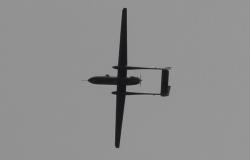Yesterday, for the third time this year, Iran said it had shot down a U.S. drone in its airspace. The United States doubted the drone had been shot down but refused to say what it had been doing near the Iran-Afghan border. NATO said the drone might have crashed in Iran after operators “lost control” of it over Afghanistan. All three stories sound fishy. If I were the CIA or the U.S. military, I’d be using our drones to spy on Iran. And if I were Iran, I’d be trying to shoot them down.
To understand how it feels to live under drones, look 1,000 miles to Iran’s west, toward the Gaza strip. Two months ago, Israeli Prime Minister Benjamin Netanyahu told the United Nations that Israel had withdrawn “from every square inch of Gaza in 2005. … We uprooted thousands of people from their homes. We pulled children out of their schools and their kindergartens. We bulldozed synagogues. We even moved loved ones from their graves.” Everything from corpses to cornerstones came out of the ground.
But not out of the air. In the sky above Gaza, Israel never fully withdrew. In 2008, I visited Israel under the sponsorship of the American Israel Public Affairs Committee. Near the Gaza border, I saw tethered airships overhead. In today’s Washington Post, Scott Wilson explains how Israeli drones are affecting Gaza. Israel no longer occupies Gaza. And yet, it does.
Israel’s occupations of land beyond its original borders—Southern Lebanon, Gaza, the West Bank—have been morally and politically costly. But Israel’s absence from these territories has been costly, too. No Israeli can forget that the country was caught unaware and nearly destroyed when its neighbors launched a coordinated assault in 1973. And as Netanyahu has pointed out, Israel’s pullouts from Gaza and Southern Lebanon brought further missile barrages from those places, not peace. By 2008, when I visited the often-bombarded Israel town of Sderot, Palestinian militants had fired thousands of rockets from Gaza into Israel.
If your country had endured such assaults, you’d want to know exactly what your neighbors were up to. You’d want a permanent intelligence—and possibly military—presence in their territory. That’s what drones have achieved. As Wilson notes, Israel developed its first surveillance drone after the 1973 war, and it escalated its aerial surveillance of Gaza after Hamas, in 2006, sneaked into Israel and kidnapped Cpl. Gilad Shalit.
As a military force, Israel’s unmanned aircraft have spared civilians more effectively than its manned aircraft have. “Because Gaza is a very dense urban environment, with civilians and terrorists mixed together, the only way to differentiate is by looking,” the commander of Israeli drones over Gaza tells Wilson. “And this is up to us to do that.” Drones can hover, observe, and verify their targets, and their strikes are more surgical. According to Wilson, “Gazans use a quick calculus to assess an attack: A destroyed building, such as the small police post, is the result of an F-16. A strike on a sedan, or a group of men clustered at an intersection, is the work of a drone.” An Islamic Jihad leader tells Wilson that Israel’s drones have killed fewer people than the Palestinian Center for Human Rights asserts, because many deaths attributed to the drones were actually inflicted by bombers or helicopters.
For both sides, then, drones are the safest way of maintaining an Israeli presence. But that doesn’t make them cost-free. Gazans tell Wilson that their kids live in fear of the drones and that they abandon their cars, cancel social plans, and stay indoors when they hear the familiar buzz. They’re afraid to be anywhere young men gather. They’re afraid to go out in clothes that might be mistaken, in the eyes of a drone pilot, for terrorist garb. “Israel’s military may not be on the ground anymore,” a Palestinian human rights advocate explains. “But they are in the air—looking, always, at every square inch of Gaza.” Despite the absence of Israeli tanks and troops, Gazans feel—and, in a sense, are—still occupied.
The Islamic Jihad leader says his men don’t yet have the weaponry to clear their skies of Israeli drones. But he indicates that they’re trying to get it and that they’re making some progress by smuggling equipment into Gaza through tunnels. If they succeed, Gaza, like Iran, could become a dangerous place for drones. That won’t make war in either place less likely. It will just force those who face terrorism from Gaza, or nuclear weapons in Iran, to strike at their enemies with less information and with clumsier, bloodier tools.
William Saletan’s latest short takes on the news, via Twitter:
